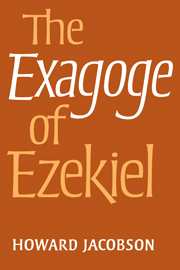APPENDIX: The Metre and Prosody of the Exagoge
Published online by Cambridge University Press: 05 March 2012
Summary
The metre and prosody of the Exagoge
In his metre and prosody Ezekiel's usage is ambiguous. In certain areas he is quite like his fifth-century tragic models, yet in others quite different. Similarly, based on the limited extant fragments of Hellenistic tragedy, we can say that in certain ways he resembles them greatly, in others not at all. Whether in this apparent stratification or conflation of traditions Ezekiel is representative of secondcentury Alexandrian tragedy or simply a unique phenomenon is something we cannot determine. It will perhaps be easiest to draw a picture of Ezekiel's overall metrical practice by examining various features singly. I have learned much from four studies, those of Wieneke (115–17), Lesky, Snell (Glotta) and Strugnell. It is unfortunate that in most cases these four scholars were unable to benefit from the work of the others. Wieneke wrote first and his research was used by the other three. But Lesky's important article of 1953 was evidently not known to Snell and Strugnell, while the latter pair had their articles appear almost simultaneously.
I. Resolution: (a) It is commonly held that the Hellenistic tragedians, like other Hellenistic authors of iambic trimeters, adopted the practice of the early iambographers rather than that of the classical tragedians and almost completely avoided resolution. This theory is, of course, based on a very limited number of verses, especially since it does not seem proper to include Lycophron's Alexandra as evidence for tragedy.
- Type
- Chapter
- Information
- The Exagoge of Ezekiel , pp. 167 - 174Publisher: Cambridge University PressPrint publication year: 1982



